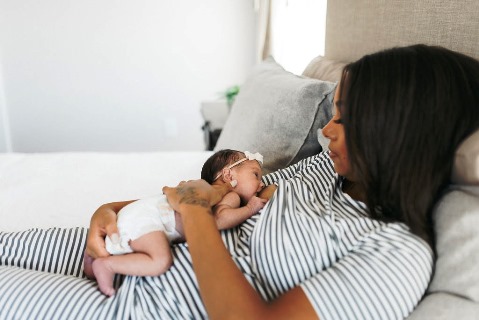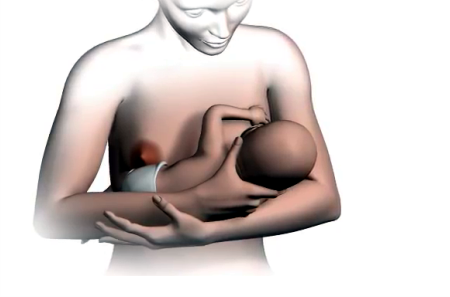Nursing Position - Mother's e-Guide
Main menu:
Postnatal
Breastfeeding and Nursing Positions.
There are many breastfeeding positions ranging from the age long conventional type to creative styles. The best approach is for a nursing mother to know what is convenient for her, stick to it and make proper use of it. Five different nursing positions are captured below:
Clutch Hold

Front View - Clutch Style

Side View of Clutch Style

Feeding Twins - Clutch Position
The Reclined Position (back- Lying)

The mother reclines on a bed supported with a pillow or leans back in a recliner. Baby lies on the stomach, pressed against the mother. The baby’s head can be supported with a pillow for more comfort. The position is effective for a baby with reflux and also when there is oversupply or a forceful downward flow of milk. The position helps to slow down the milk flow for the baby. It is equally good when the mother’s breasts are large. The recline-style often times is the first mother’s attempt. After the baby is born and placed on the mother’s chest, skin-to-skin contact will help stimulate his feeding instincts. This will make him work his way towards one of the breasts (aka breast crawl) and tries to feed for the first time outside the womb. This position is not only for new babies, it is also for babies of any age still breastfeeding. It may be really useful for babies struggling to latch in other positions.
Cradle Hold

The age-long classic position in which the baby is cuddled; held in the elbow
area of the arm for support. Some hold that, though an excellent composure, yet
it may not be easy to use the position for a newborn or it may be difficult to
breastfeed in this position right from the start. However, pillow can be used for support to
achieve the easiness.
Cross-Cradle Position

...different from the
CRADLE HOLD because the baby’s head is supported using the hand opposite the
breast for feeding. As a result, there is more control in positioning the baby; mainly to support the baby around the neck and
shoulders which will allow him to tilt his head before latching. The baby is tucked in towards the mother’s body:
belly-to-belly. The mother’s other hand is free in supporting the breast. ‘Cross-cradle’ is great for new babies
especially for the ones that find it difficult to latch.
Side Lying Position

In this position, the mother and child are both relaxed; lying side by side, belly to belly next to each other - a natural choice for night time feedings. This position can be more soothing most especially if the mother had undergone caesarean delivery. The position also excels in keeping the baby’s head at a good angle to the breast.

In conclusion, whatever style opted for, it is advisable to alternate the positions chosen which will allow the baby to more effectively drain the different areas of the breasts. Resultantly, it will help to prevent stuck milk ducts and some other common problems of the breast.
Home Page | Antenatal | Postnatal | Neonatal | Healthy Tips | FAQ | Trainers Pack | Extras | General Site Map
